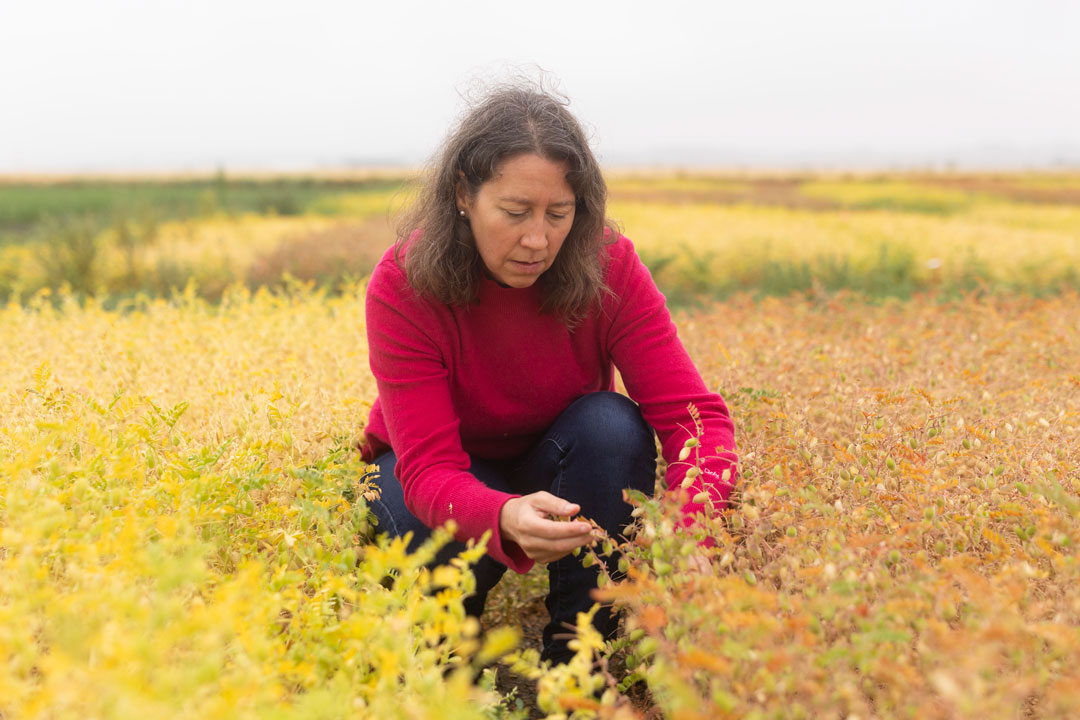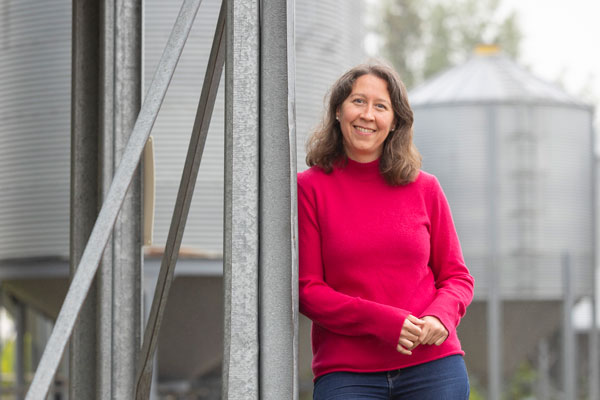
WGRF Integrated Agronomy Chair focuses on sustainable cropping systems
“We try things that people are thinking about but perhaps not trying themselves.” – Dr. Maryse Bourgault (PHD)
By Kathy FitzpatrickFor Dr. Maryse Bourgault (PhD), multi-disciplinary research in sustainable agriculture goes far beyond crop physiologists, soil scientists, plant pathologists, and other scientific experts. The conversation extends to agricultural economists, executives of food processing companies, consumers, and most crucially, farmers.
Of new practices and technologies, producers want to know “’how much does it cost, how much can I save, and how much is it going to make me?’” Bourgault recalls hearing from Kathy Larson, a professional research associate in the Department of Agricultural and Resource Economics in the College of Agriculture and Bioresources. “These are the questions that we also want to consider,” said Bourgault.
Bourgault arrived at the University of Saskatchewan’s (USask) College of Agriculture and Bioresources in March 2020, as the first Western Grains Research Foundation (WGRF) Integrated Agronomy Chair.
Prior to that, she earned a PhD in crop physiology at McGill University’s Faculty of Agriculture and Environmental Sciences. Bourgault then spent nine years in Australia, completing two post-doctoral fellowships at the Commonwealth Scientific and Industrial Research Organisation (CSIRO) and the University of Melbourne, followed by 15 months as an extension officer with the Queensland State Department of Primary Industries. From there, she went on to a research centre at Montana State University. She also found time to complete an MBA in agribusiness from Université Laval in 2021.
Bourgault’s ultimate mission at USask is to help improve soil management and increase crop production in sustainable ways. She aims to look at sustainability through multiple lenses: environmental, economic and social. She wants to assess how new practices fit into the overall farming system and affect quality of life and examine their potential for widespread acceptance.
In planning her research, one of Bourgault’s earliest activities was to ask farmers what they felt were their most pressing issues, and what the solutions with the greatest impact may be. She said cover crops—a “fairly new” practice—was one topic raised. It’s thought that covering the soil with crops such as clover or alfalfa, especially early and late in the growing season, can reduce wind erosion and fix nitrogen in the soil as well as draw in moisture from snow melt and rain. That benefits other crops planted in the same soil, such as wheat and canola.
Bourgault said interest in this practice is growing, due in part to its promotion by Farmers for Climate Solutions, a group advocating to make agriculture part of the solution to climate change. The group offers farmer-to-farmer mentorship, but even so “people are desperate for information on what works and what doesn’t. And there is no sound scientific information behind it,” said Bourgault.
Cover cropping is now another one of her projects, in collaboration with partners Dr. Linda Gorim (PhD) at the University of Alberta and Dr. Yvonne Lawley (PhD) at the University of Manitoba.
Another practice, placing the fertilizer phosphorous more deeply in the soil where it can reach plant roots, is also catching the attention of farmers in Saskatchewan. It’s now the subject of a research project being conducted by Bourgault’s technician from Montana, who came to USask for a PhD program. Bourgault noted that there has not been much work done on placing phosphorous at depth since the introduction of no-till farming, which has resulted in the common practice of placing fertilizer within five centimetres of the soil surface.

Part of what drew her to the position at USask was the chance to investigate alternative farming practices, including reintegrating livestock into grain crop production. The strategy is part of an approach known as regenerative agriculture, so named for its aim to mitigate climate change by sequestering carbon while restoring soil health and biodiversity, reducing the use of water and other inputs, and improving farm productivity and profitability.
For Bourgault, the college’s central location on campus, the opportunity to teach and interact with students, and the broad range of disciplines at the college were important draws. So was the possibility of accessing the Livestock and Forage Centre of Excellence in nearby Clavet, Sask.
“I could see a lot of possibilities, a lot of needed research, and good support from the industry,” said Bourgault.
Her role is supported with $2 million in funding over seven years from WGRF, a farmer-funded and farmer-directed nonprofit organization.
One of Bourgault’s reintegration studies involves a closer working relationship between the production of field crops and livestock grazing. “They call me ‘the fence lady,” she said, smiling, for the extensive network of electric fences weaving through her test plots. The thinking is that “livestock grazing, with the manure that comes with it, might help with carbon sequestration and soil health in cropping systems,” explained Bourgault.
As well, she is looking at potential winter crop rotations, along with new winter crops with the goal to offer less susceptibility to drought and August heat. Winter camelina in the 2020-21 crop year was one success.
Early in the 2020 growing season “everyone was panicking because it was so dry. For us, by the time people were starting to get worried, the winter camelina was maturing,” she said.
A two-year study on intercropping various legumes with cereals or oilseeds (planting alternating rows) yielded some surprises.
“Sometimes the interesting results are not what worked butwhat didn’t work,” said Bourgault.
For instance, it turned out oats and wheat are too competitive to intercrop with faba beans, and legume monocrops were better at improving the soil health indicators considered. One encouraging result came from intercropping peas and canola. It saved about 30 pounds of nitrogen per acre, because the canola did not have to be fertilized—the nitrogen-fixing peas did the job.
“That was pretty amazing,” said Bourgault, noting a multiyear study to see how much fertilizer can be saved over time may be worth undertaking.
Bourgault also wants to make sure the solutions she investigates translates to field-scale production and are sustainable, perhaps by having farmers test new practices with their own equipment.
“There might be real barriers that we don’t see because that’s not part of our reality,” she explained. She said so far it has been difficult to find money to compensate participants and will take more work to persuade funding agencies of the value in doing this.
Beyond the technical questions, Bourgault sees the need for discussion across society of what constitutes sustainable or regenerative food production. If farmers, food processors, and consumers hold differing views, there is potential for conflict and the erosion of trust.
She also sees a role for social scientists in assessing the potential for consumer acceptance. Noting that intercropping, for example, is an easy sell because the fields often look so pretty, Bourgault said “people see that, and they feel good inside.” She wonders if people can be persuaded “to pay a little bit more of a premium for crops that are grown in a different way.”
There are many urgent questions involving many players about how to grow higher-quality food and more of it, more profitably and sustainably, in changing climates. For her part in finding answers, Bourgault believes “it’s not difficult to see the impact that we’ll have on society.”
Together, we will undertake the research the world needs. We invite you to join by supporting critical research at USask.

